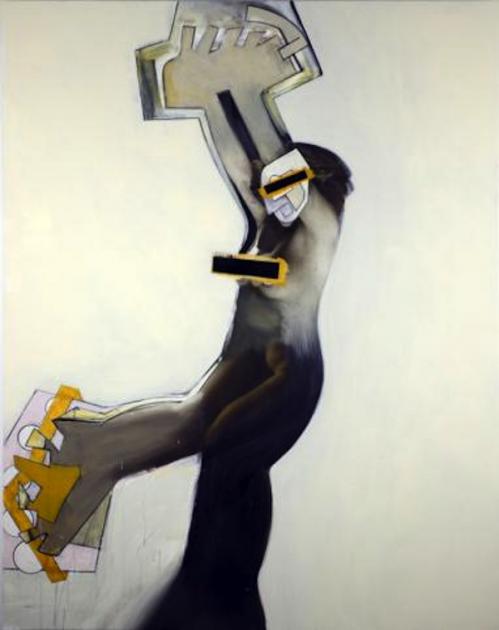A new exhibition of paintings by Richard Prince, his first exhibition in London since his ‘Continuation’ retrospective at the Serpentine Gallery in 2008, will be held at Sadie Coles in London. These fourteen expansive canvases build upon a series of works inspired by Picasso which was unveiled at the Museo Picasso, Malaga, in 2012. Each canvas features an over-painted ink-jet print of a single female figure or giantess – a symbolic hybrid of Prince and Picasso. The women teeter between the appearance of neoclassical marbles and fragments of soft porn. Through Prince’s interventions in acrylic, the torsos metamorphose into gigantic sculptural bodies, with wrestling mask heads and elongated, angular limbs painted in grisaille tones.
In line with much of Prince’s art, the paintings grapple with the idea of influence, reusing and deconstructing Picasso’s iconography in order to mount a challenge to his iconic aura. In the late 2000s, Prince began a cycle of paintings which similarly corrupted Willem de Kooning’s ‘Women’ series – conflating the originals with pornographic ink-jet prints and sections of expressive, ‘painterly’ brushwork. In the Picasso paintings, Prince takes on the most pervasive influence of all on twentieth-century art (Jackson Pollock, another significant inspiration of Prince’s, famously hurled a Picasso book against his studio wall, and emerged saying: “Goddamn it! That guy has done everything. There’s nothing left.”)
Prince has acknowledged Picasso’s influence (“he’s who I grew up with. I’ve always made drawings after Picasso”) but at the same time, he gleefully deconstructs his canonical, quasi ‘Old Master’ status, reconfiguring and caricaturing his signature imagery. The figures’ masked faces, box-like appendages and clubbed extremities often jar absurdly with their agile poses. In defiance of Picasso’s fervent movement away from photographic styles of representation, Prince cheekily injects photography back into the picture. These works profess their source – their debt to Picasso as well as Abstract Expressionism – at the same time as they express a close sympathy with (and perhaps a nostalgia for) the grand painterly statements of Modernism.
Prince plays out – even satirises – the way the female nude is mapped and multiplied in Picasso’s paintings, suggesting Picasso’s own debt to the past (particularly classical nudes) as well as his proximity to more overtly sexualized images. Of the anatomy books he raids, Prince remarks: “they’re very generic. They don’t belong to anyone”. These works highlight the generic ways in which the female nude continues to be visualised (each figure is pointedly faceless, and one has censorious anonymising black lines across her breasts and eyes). All the while, Prince’s paintings assert the undying relevance of art which deals with the body and its portrayal: discussing Picasso’s artist and model series, he has commented “its subject matter that’s there everyday. He never lets go of the body”.
Prince emerged in the 1970s as one of the leading exponents of appropriation art in New York. Throughout his career, he has employed various media to cite and subtly parody the visual and verbal clichés of American popular culture – whether in the ‘Cowboys’ series in which he ‘re-photographed’ the mythic cowboy imagery of Marlboro adverts, or the celebrated series of ‘Nurse’ paintings based on the covers of pulp fiction novels which these nudes can be seen to relate to. Prince exposes, and subtly critiques, the underlying ideological and cultural assumptions, holding up a mirror to American society.
Richard Prince (b. 1949, Panama Canal Zone) had his first solo museum show in 1983 at the Institute of Contemporary Art in London, and has since had numerous solo exhibitions internationally, Prince/Picasso, Museo Picasso Málaga, Spain, 2012; Richard Prince. American Prayer, Bibliothèque Nationale de France, Paris, 2011; Continuation at the Serpentine Gallery, London, 2008, and Richard Prince: Spiritual America at the Solomon R. Guggenheim Museum, New York, in 2008.
HQ : 01 February – 16 March 2013 4 New Burlington Place, London W1

